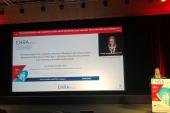Warfarin May Speed Progression of Aortic Stenosis and Worsen Outcomes
The findings are not definitive, but they should be considered when choosing an anticoagulant, Samir Kapadia says.

Use of warfarin appears to not only accelerate progression of aortic stenosis (AS) and increase the likelihood of needing an aortic valve replacement (AVR), but also may raise the risk of dying in patients with mild or moderate AS, a study shows.
Compared with patients taking a direct oral anticoagulant (DOAC), those on warfarin had a greater reduction in aortic valve area and a larger increase in mean gradient over time, according to researchers led by Essa Hariri, MD (Cleveland Clinic, OH).
After accounting for potential confounders, warfarin users were more likely to undergo AVR and to die from any cause, Hariri et al report in a research letter published Monday in the Journal of the American College of Cardiology.
These findings likely can be explained by warfarin’s effects on calcification, senior author Samir Kapadia, MD (Cleveland Clinic), told TCTMD, noting that by inhibiting the vitamin K2 pathway, the anticoagulant can cause calcium to accumulate in the vascular system and in the aortic valve itself.
Evidence of a link between warfarin use and systemic calcification has been emerging in recent years.
A 2018 study in JACC: Cardiovascular Imaging by Kapadia and colleagues showed that warfarin therapy was associated with progressive coronary atheroma calcification in patients with CAD. An analysis published earlier this year in Heart demonstrated that patients with mild or moderate AS who were taking calcium supplements had elevated risks of all-cause and CV death and AVR compared with no supplementation. Finally, a study published in the European Heart Journal – Cardiovascular Imaging showed that longer use of a vitamin K antagonist (VKA)—but not a DOAC—was associated with an increasing aortic valve calcification score.
“We cannot say with certainty that you should not take Coumadin if you have moderate AS, and [that you should] take a DOAC, but this should be a consideration,” Kapadia said, noting that DOACs have been shown to be at least as safe as warfarin.
Varied Underlying Pharmacodynamic Mechanisms
To further explore the potential for warfarin to have an impact on AS progression and outcomes, Hariri, Kapadia, and colleagues turned to the Cleveland Clinic Echocardiography Database. The analysis included 2,385 patients 60 and older (mean age 75; 44% women) who had native AS classified as mild (31%) or moderate (69%) and were treated between January 2008 and June 2018. Overall, 23% were taking warfarin and 7% were taking a DOAC; the most common indication was atrial fibrillation (about 80%).
Over a median follow-up of about 5.6 years, 30% of patients underwent AVR and 20% died.
On multivariable adjustment, warfarin was associated with a greater risk of all-cause mortality compared with either no anticoagulation (adjusted HR 1.34; 95% CI 1.07-1.68) or DOAC therapy (adjusted HR 1.47; 95% CI 1.18-2.02). The findings were similar when stratified by the presence of CAD or LV function.
Warfarin users also had a higher risk of AVR compared with those taking a DOAC (adjusted HR 1.46; 95% CI 1.08-1.98), whereas DOAC users had a lower risk of valve replacement compared with those who were not on any anticoagulation (adjusted HR 0.61; 95% CI 0.46-0.81).
Compared with DOAC-treated patients, warfarin users had a greater median annualized change in aortic valve area (-7.02 vs -5.30 mm2) and larger increase in mean gradient (1.63 vs 1.02 mm Hg).
“Our findings suggest that the varied underlying pharmacodynamic mechanisms between warfarin and DOACs is central to the observed divergences in hemodynamic and clinical measures in AS,” the researchers write.
“In particular, faster valvular progression among warfarin users is likely related to enhanced valvular calcification secondary to reduced activation of vitamin K–dependent proteins with anticalcification properties, including matrix gammacarboxyglutamate protein and osteocalcin,” they explain. “Moreover, a state of vitamin K deficiency and consequent decrease in serum matrix gamma-carboxyglutamate protein induced by warfarin is associated with adverse effects not solely on the aortic valve but also on vascular integrity, including arterial stiffness and endothelial function and cardiac remodeling in states of chronic pressure overload, as well as myocardial structure and function, which ultimately may lead to higher mortality in such patients.”
Confirms and Expands on Earlier Work
Brian Lindman, MD (Vanderbilt University Medical Center, Nashville, TN), commenting on the study for TCTMD, said the study confirms and expands on an earlier paper published as a research letter in the same journal. That analysis also showed that warfarin therapy was associated with faster progression of AS. The worse clinical outcomes seen in the analysis by Hariri et al make sense if the disease is advancing more rapidly, Lindman said.
As for whether the impact of warfarin on the vitamin K pathway and calcification is enough to explain to poorer clinical outcomes, Lindman said it’s possible, although he pointed out that a recent randomized trial published in Circulation showed that providing vitamin K and vitamin D supplementation to patients with AS did not slow calcification of the valve. Only a minority of those patients were on oral anticoagulation, however.
With multiple observational studies demonstrating faster progression of AS with warfarin versus DOACs, and with a large population of patients with both AS and an indication for oral anticoagulation, a randomized trial comparing the two anticoagulant options in this population could be an important next step, Lindman said. He acknowledged that questions of equipoise could make enrollment in such a trial difficult, as many patients may have a preference for DOAC therapy and would not want to take the chance of being randomized to warfarin.
In the absence of that type of study, it would be a “reasonable extrapolation” to look at data from the pivotal atrial fibrillation trials of DOACs versus warfarin and opt for a DOAC in patients with AS to avoid potential warfarin-related issues with calcification, Lindman said.
“You have existing reasons from other trials to maybe favor a DOAC over warfarin in terms of bleeding risk and stroke risk,” he told TCTMD, “and this is just another reason that’s particularly relevant to the population with aortic stenosis that might push [patients] even further to say, ‘Hey, I really do want to take a DOAC.’”
Kapadia said another question that can be addressed with future research is whether these findings could apply to patients with prosthetic heart valves as well, and whether the choice of warfarin or a DOAC influences longer-term disease progression and outcomes in that population.
Todd Neale is the Associate News Editor for TCTMD and a Senior Medical Journalist. He got his start in journalism at …
Read Full BioSources
Hariri EH, Kassis N, Badwan OZ, et al. Impact of oral anticoagulation on progression and long-term outcomes of mild or moderate aortic stenosis. J Am Coll Cardiol. 2022;80:181-183.
Disclosures
- The study was supported by unrestricted philanthropic support to the Cleveland Clinic Heart, Vascular, and Thoracic Institute.
- Hariri and Kapadia report no relevant conflicts of interest.





Comments